2003 MERCEDES-BENZ E320 WAGON fuel cap
[x] Cancel search: fuel capPage 249 of 354

246 Malfunction and indicator lamps
Te ch n i c a l
data Instruments
and controlsOperation DrivingInstrument
cluster displayPractical hints Car care Index
Supplemental restraint system (SRS) indicator lamp
The operational readiness of the airbag
system is verified by the indicator lamp SRS
in the instrument cluster when turning the
electronic key in steering lock to position 1 or 2. If no
malfunction is detected, the lamp will go out after
approximately 4 seconds; after the lamp goes out, the
system continues to monitor the components and
circuitry of the airbag system and will indicate a
malfunction by coming on again.
See page 68 for notes on airbags, see page 67 for belt
tensioners and page 57 for infant and child seat
restraint.Fuel reserve and fuel cap placement warning
When the warning lamp (1) comes on after starting the
engine, or if it comes on while driving, it indicates that
the fuel level is down to the reserve quantity of
approximately 2.6 gal (10 liters).
The warning lamp blinks when the fuel cap is not
closed, or a fuel system leak has been detected.
Retighten cap and see if lamp goes out after restart and
next OBD selfcheck.
If the warning lamp continues to blink after closing the
fuel cap correctly, have the fuel system checked at your
authorized Mercedes-Benz Center as soon as possible.
Leaving the engine running and the fuel cap open can
also cause the “CHECK ENGINE” lamp to illuminate, see
also page 244.
Wa r n i n g !
In the event a malfunction of the SRS is indicated
as outlined above, the SRS may not be operational.
For your safety, we strongly recommend that you
visit an authorized Mercedes-Benz Center
immediately to have the system checked; otherwise
the SRS may not be activated when needed in an
accident, which could result in serious or fatal
injury, or it might deploy unexpectedly and
unnecessarily which could also result in injury.SRS
1
P54.30-4557-21
Page 291 of 354
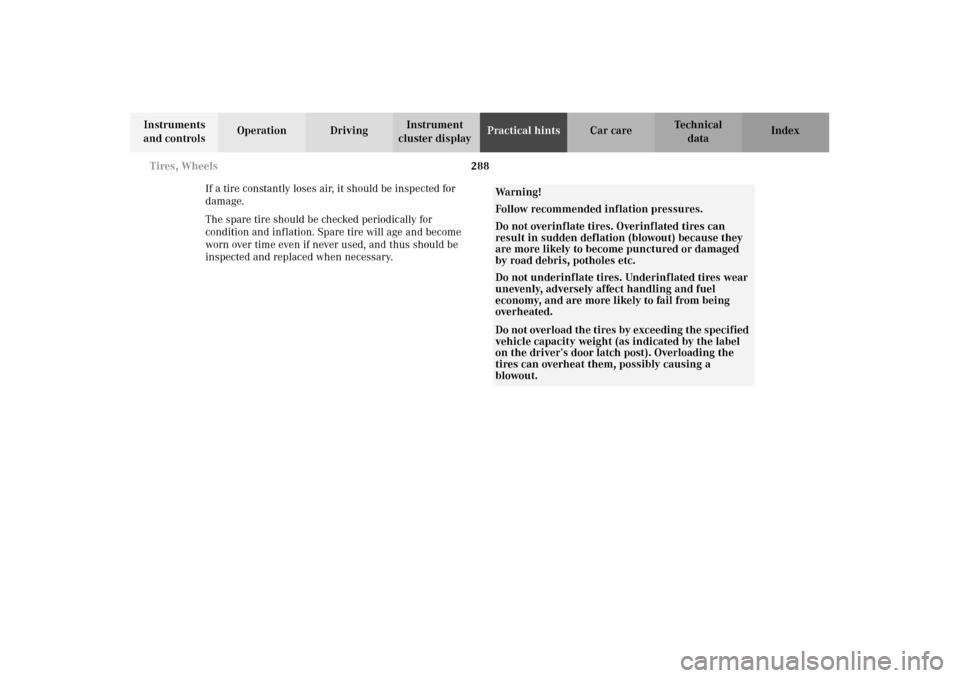
288 Tires, Wheels
Te ch n i c a l
data Instruments
and controlsOperation DrivingInstrument
cluster displayPractical hintsCar care Index
If a tire constantly loses air, it should be inspected for
damage.
The spare tire should be checked periodically for
condition and inflation. Spare tire will age and become
worn over time even if never used, and thus should be
inspected and replaced when necessary.
Wa r n i n g !
Follow recommended inflation pressures.
Do not overinflate tires. Overinflated tires can
result in sudden deflation (blowout) because they
are more likely to become punctured or damaged
by road debris, potholes etc.
Do not underinflate tires. Underinflated tires wear
unevenly, adversely affect handling and fuel
economy, and are more likely to fail from being
overheated.Do not overload the tires by exceeding the specified
vehicle capacity weight (as indicated by the label
on the driver’s door latch post). Overloading the
tires can overheat them, possibly causing a
blowout.
Page 324 of 354
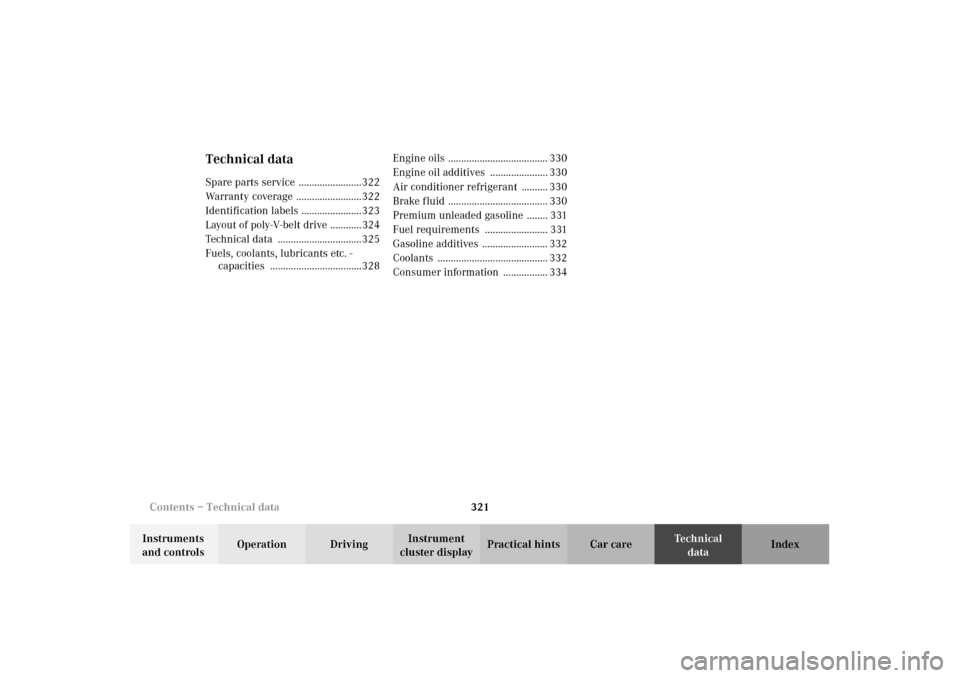
321 Contents – Technical data
Te ch n i c a l
data Instruments
and controlsOperation DrivingInstrument
cluster displayPractical hints Car care Index
Technical dataSpare parts service ........................322
Warranty coverage .........................322
Identification labels .......................323
Layout of poly-V-belt drive ............324
Technical data ................................325
Fuels, coolants, lubricants etc. -
capacities ...................................328Engine oils ...................................... 330
Engine oil additives ...................... 330
Air conditioner refrigerant .......... 330
Brake fluid ...................................... 330
Premium unleaded gasoline ........ 331
Fuel requirements ........................ 331
Gasoline additives ......................... 332
Coolants .......................................... 332
Consumer information ................. 334
Page 331 of 354
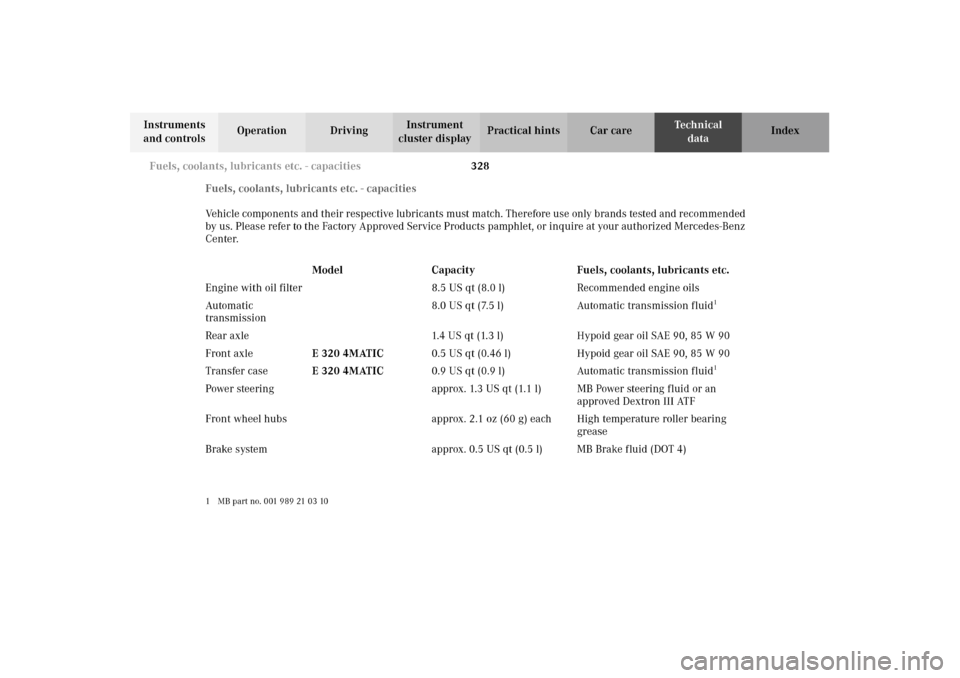
328 Fuels, coolants, lubricants etc. - capacities
Te ch n i c a l
data Instruments
and controlsOperation DrivingInstrument
cluster displayPractical hints Car care Index
Fuels, coolants, lubricants etc. - capacities
Vehicle components and their respective lubricants must match. Therefore use only brands tested and recommended
by us. Please refer to the Factory Approved Service Products pamphlet, or inquire at your authorized Mercedes-Benz
Center.
Model Capacity Fuels, coolants, lubricants etc.
Engine with oil filter 8.5 US qt (8.0 l) Recommended engine oils
Automatic
transmission8.0 US qt (7.5 l) Automatic transmission fluid
1
Rear axle 1.4 US qt (1.3 l) Hypoid gear oil SAE 90, 85 W 90
Front axleE 320 4MATIC0.5 US qt (0.46 l) Hypoid gear oil SAE 90, 85 W 90
Transfer caseE 320 4MATIC0.9 US qt (0.9 l) Automatic transmission fluid
1
Power steering approx. 1.3 US qt (1.1 l) MB Power steering fluid or an
approved Dextron III ATF
Front wheel hubs approx. 2.1 oz (60 g) each High temperature roller bearing
grease
Brake system approx. 0.5 US qt (0.5 l) MB Brake fluid (DOT 4) 1 MB part no. 001 989 21 03 10
Page 332 of 354
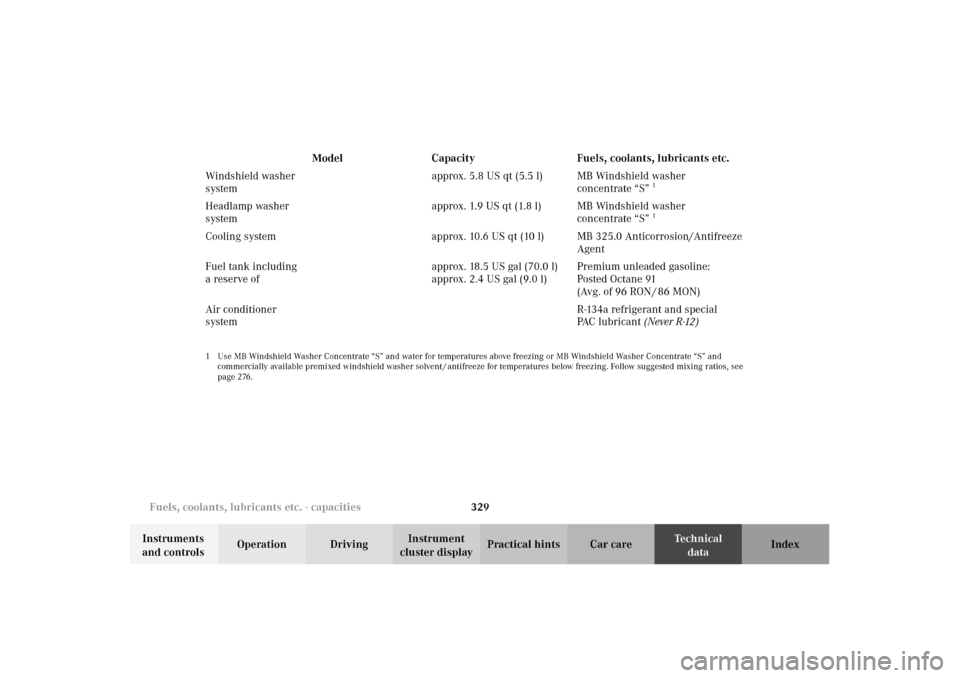
329 Fuels, coolants, lubricants etc. - capacities
Te ch n i c a l
data Instruments
and controlsOperation DrivingInstrument
cluster displayPractical hints Car care Index Windshield washer
systemapprox. 5.8 US qt (5.5 l) MB Windshield washer
concentrate “S”
1
Headlamp washer
systemapprox. 1.9 US qt (1.8 l) MB Windshield washer
concentrate “S”
1
Cooling system approx. 10.6 US qt (10 l) MB 325.0 Anticorrosion/Antifreeze
Agent
Fuel tank including
a reserve ofapprox. 18.5 US gal (70.0 l)
approx. 2.4 US gal (9.0 l)Premium unleaded gasoline:
Posted Octane 91
(Avg. of 96 RON / 86 MON)
Air conditioner
systemR-134a refrigerant and special
PA C l u b r i c a n t (Never R-12)1 Use MB Windshield Washer Concentrate “S” and water for temperatures above freezing or MB Windshield Washer Concentrate “S” and
commercially available premixed windshield washer solvent / antifreeze for temperatures below freezing. Follow suggested mixing ratios, see
page 276.
Model Capacity Fuels, coolants, lubricants etc.
Page 333 of 354

330 Fuels, coolants, lubricants etc. - capacities
Te ch n i c a l
data Instruments
and controlsOperation DrivingInstrument
cluster displayPractical hints Car care Index
Engine oils
Engine oils are specifically tested for their suitability in
our engines. Therefore, use only engine oils
recommended by Mercedes-Benz. Information on
recommended brands is available in the Factory
Approved Service Products pamphlet , or at your
authorized Mercedes-Benz Center.
Please follow Service Booklet recommendations for
scheduled oil changes. Failure to do so could result in
engine damage not covered by the Mercedes-Benz
Limited Warranty.
Engine oil additives
Do not blend oil additives with engine oil. They may be
harmful to the engine operation.
Damage or malfunctions resulting from blending oil
additives are not covered by the Mercedes-Benz Limited
Warranty.Air conditioner refrigerant
R-134a (HFC) refrigerant and special PAG lubricating oil
is used in the air conditioner system.
Never use R-12 (CFC) or mineral-based lubricating oil,
otherwise damage to the system will occur.
Brake fluid
During vehicle operation, the boiling point of the brake
fluid is continuously reduced through the absorption of
moisture from the atmosphere. Under extremely hard
operating conditions, this moisture content can lead to
the formation of bubbles in the system thus reducing
the system’s efficiency.
The brake fluid must therefore be replaced every two
years, preferably in the spring.
It is recommended to use only brake fluid approved by
Mercedes-Benz. Your authorized Mercedes-Benz Center
will provide you with additional information.
Page 334 of 354
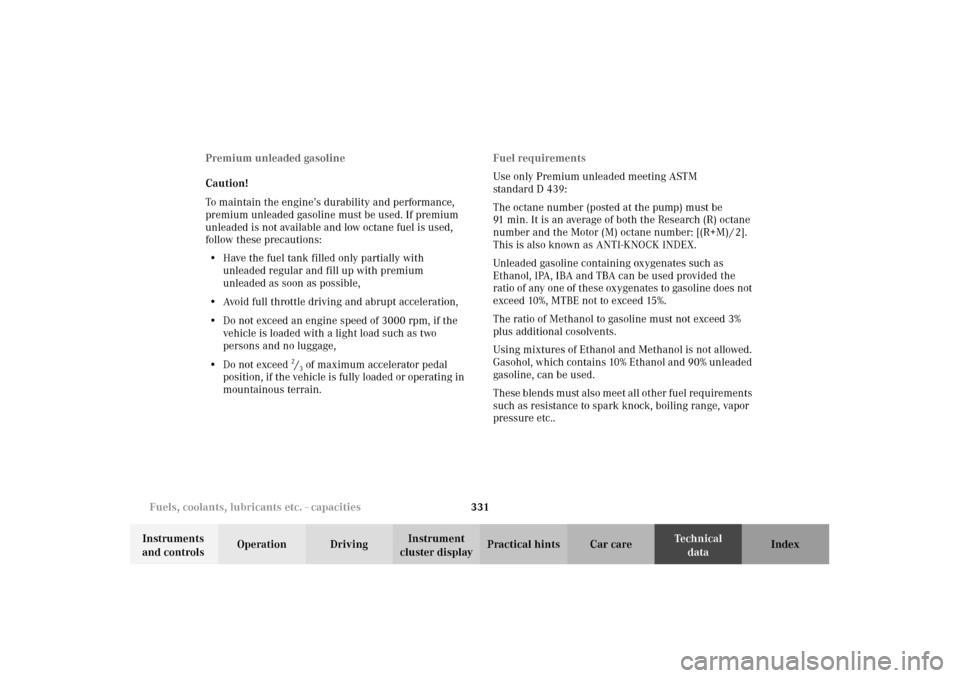
331 Fuels, coolants, lubricants etc. - capacities
Te ch n i c a l
data Instruments
and controlsOperation DrivingInstrument
cluster displayPractical hints Car care Index Premium unleaded gasoline
Caution!
To maintain the engine’s durability and performance,
premium unleaded gasoline must be used. If premium
unleaded is not available and low octane fuel is used,
follow these precautions:
•Have the fuel tank filled only partially with
unleaded regular and fill up with premium
unleaded as soon as possible,
•Avoid full throttle driving and abrupt acceleration,
•Do not exceed an engine speed of 3000 rpm, if the
vehicle is loaded with a light load such as two
persons and no luggage,
•Do not exceed
2/3 of maximum accelerator pedal
position, if the vehicle is fully loaded or operating in
mountainous terrain.Fuel requirements
Use only Premium unleaded meeting ASTM
standard D 439:
The octane number (posted at the pump) must be
91 min. It is an average of both the Research (R) octane
number and the Motor (M) octane number: [(R+M) / 2].
This is also known as ANTI-KNOCK INDEX.
Unleaded gasoline containing oxygenates such as
Ethanol, IPA, IBA and TBA can be used provided the
ratio of any one of these oxygenates to gasoline does not
exceed 10%, MTBE not to exceed 15%.
The ratio of Methanol to gasoline must not exceed 3%
plus additional cosolvents.
Using mixtures of Ethanol and Methanol is not allowed.
Gasohol, which contains 10% Ethanol and 90% unleaded
gasoline, can be used.
These blends must also meet all other fuel requirements
such as resistance to spark knock, boiling range, vapor
pressure etc..
Page 335 of 354
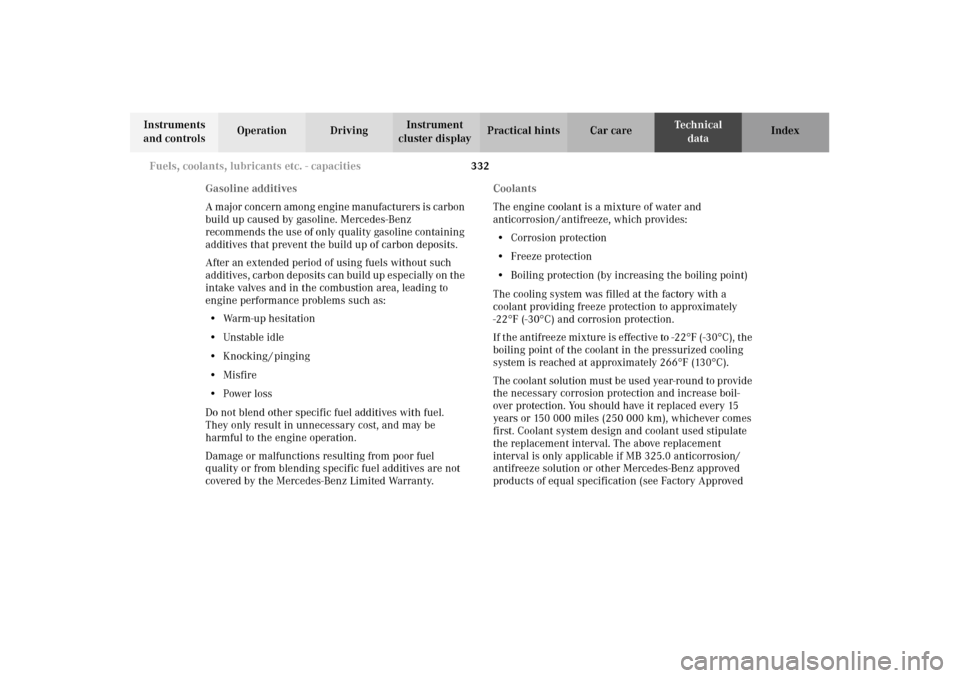
332 Fuels, coolants, lubricants etc. - capacities
Te ch n i c a l
data Instruments
and controlsOperation DrivingInstrument
cluster displayPractical hints Car care Index
Gasoline additives
A major concern among engine manufacturers is carbon
build up caused by gasoline. Mercedes-Benz
recommends the use of only quality gasoline containing
additives that prevent the build up of carbon deposits.
After an extended period of using fuels without such
additives, carbon deposits can build up especially on the
intake valves and in the combustion area, leading to
engine performance problems such as:
•Warm-up hesitation
•Unstable idle
•Knocking / pinging
•Misfire
•Power loss
Do not blend other specific fuel additives with fuel.
They only result in unnecessary cost, and may be
harmful to the engine operation.
Damage or malfunctions resulting from poor fuel
quality or from blending specific fuel additives are not
covered by the Mercedes-Benz Limited Warranty.Coolants
The engine coolant is a mixture of water and
anticorrosion / antifreeze, which provides:
•Corrosion protection
•Freeze protection
•Boiling protection (by increasing the boiling point)
The cooling system was filled at the factory with a
coolant providing freeze protection to approximately
-22
°F (-30
°C) and corrosion protection.
If the antifreeze mixture is effective to -22
°F (-30
°C), the
boiling point of the coolant in the pressurized cooling
system is reached at approximately 266
°F (130
°C).
The coolant solution must be used year-round to provide
the necessary corrosion protection and increase boil-
over protection. You should have it replaced every 15
years or 150 000 miles (250 000 km), whichever comes
first. Coolant system design and coolant used stipulate
the replacement interval. The above replacement
interval is only applicable if MB 325.0 anticorrosion/
antifreeze solution or other Mercedes-Benz approved
products of equal specification (see Factory Approved